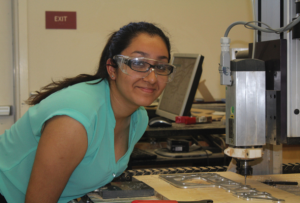 Simon Tran is on the fast track.
Simon Tran is on the fast track.
A junior at the Kearny High School of Digital Media and Design in San Diego, Simon makes the most of learning in a school with a digital media arts industry theme. While mastering the use of cutting-edge digital design equipment, he’s building his leadership skills by collaborating with peers, working under the guidance of mentors, gaining experience working with clients, and earning college credits by taking community college classes through Kearny’s “Fast Track” program.
“Our projects are linked to the school’s learning outcomes,” Simon explains, “so we are always working on critical thinking, innovation, and civic engagement. Our clients won’t settle for good enough work; they want great finished products that they can really use.”
Up north in Sacramento, Gabriela (Gaby) Vargas will graduate this year from the School of Engineering and Sciences (SES). Starting in 7th grade, SES students take all their middle and high school courses in a science, technology, engineering and math (STEM) industry-themed pathway, where they work on projects and gain experiences that help them refine their college and career plans.
“For the past six years,” reports Gaby, “I’ve learned the ins and outs of design and manufacturing processes through my school’s integrated curriculum, participating in internships, and after-school robotics.”

Linked Learning
Simon and Gaby are just two of thousands of California students who are enrolled in a Linked Learning program of study. Linked Learning schools, or pathways, have an industry theme and integrate rigorous college-preparatory academics, sequenced career technical training that meets industry standards, and meaningful professional experiences alongside employer partners. Their connections to community and business partners expand learning beyond the walls of high school, and help them become college and career ready, with the skills and mindsets needed for lifelong achievement.
With equity as a central focus, students also receive personalized supports to ensure that they remain on track for postsecondary and professional success.
One of California’s competitive advantages has been a skilled workforce for many growing industries. In a sea of high costs, our well-trained college graduates have stoked the growth of companies in both long-established and cutting- edge industries.
We can maintain that advantage only by ensuring a steady pipeline of well-trained and highly motivated young workers.
Youth employment is at a historic low and the projected workforce skills gap is growing in many industry sectors. California’s unemployment rate for youth ages 16–19 is 19.6%, and for ages 20–24 is 9.9%, compared with an overall unemployment rate of 5.3%.
Partnership
Addressing youth employment will require a focused response from educators, business leaders, and government officials. To that end, the California Chamber of Commerce and the Linked Learning Alliance have partnered with the U.S. Chamber of Commerce Foundation to expand opportunities for teenagers and young adults to have work experiences that lead to college and career advancement.
Work-based learning includes a range of hands-on learning and out-of-classroom opportunities that expose students to professionals and real world work environments. These opportunities, which include guest speeches from industry representatives, participation in job shadows, worksite tours, and engagement in informational interviews, build on each other and culminate in a formal internship experience.
Through these opportunities, students learn about career opportunities and what it takes to thrive in the professional world.
LaunchPath
California has been at the forefront of using technology platforms to make it easier for employers to develop or expand work-based learning opportunities for teens and young adults. One tool being tested is LaunchPath, an online platform that matches employers who want to offer work-based learning opportunities and students who have preparation to be productive in the workplace.
Gaby obtained her internship at Aerojet Rocketdyne through LaunchPath.
This service includes online badging, which provides information about students’ prior experience that employers need to make a smart hire. Badges are a visual way that students can showcase the industry sector skills they have gained, highlight their career readiness, and promote successful internships they have completed — accomplishments that grades and resumes can’t communicate.
“Employers are essential partners in Linked Learning,” said Christopher Cabaldon, president of the Linked Learning Alliance. “Because Linked Learning students get technical and academic training in industry-themed pathways, they are prepared to contribute in the workplace during their internships. The interaction with employers is key for students to gain skills needed to succeed in both college and career.”
Nobody knows this better than Gaby and Simon. Simon is making plans to study computer science in college. Come September, Gaby will be commencing the mechanical engineering program at Cal Poly San Luis Obispo. After college, she plans to work in industry for a few years before returning to a school like SES where she can inspire future engineers and scientists.
Note: Loren Kaye, president of the California Foundation for Commerce and Education (CFCE), co-authored this article with Rebecca Sterling, program manager at the Linked Learning Alliance, responsible for managing the organization’s enterprise solutions, including LaunchPath, the online work-based learning platform, and the data and certification systems. CFCE is a nonprofit, nonpartisan think tank affiliated with the California Chamber of Commerce. Linked Learning Alliance is a statewide coalition of education, industry, and community organizations dedicated to improving California’s high schools and preparing students for success in college, career and life. The article originally appeared at Forbes.com.
For more information about pathways to employment for young people, go to the Grads of Life website at gradsoflife.org.

